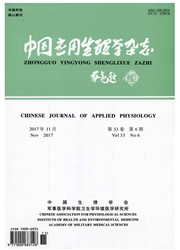

 中文摘要:
中文摘要:
The primary object of this fundamental research was to survey the synergistic cardiovascular effects of iptakalim, a novel ATP–sensitive potassium channel(KATP) opener, and clinical first-line antihypertensive drugs, such as calcium antagonists, thiazide diuretics and β receptor blockers by a 2×2 factorial-design experiment. It would provide a theoretical basis for the development of new combined antihypertensive therapy program after iptakalim is applied to the clinic. Amlodipine besylate, hydrochlorothiazide and propranolol were chosen as clinical first-line antihypertensive drugs. Blood pressure, heart rate(HR) and cardiac functions were observed in anesthetized normal rats by an eightchannel physiological recorder. The results showed that iptakalim monotherapy in a low dose could produce significant antihypertensive effect. There was no interaction between iptakalim and amlodipine on the maximal changes of systolic blood pressure(SBP), diastolic blood pressure(DBP), mean arterial blood pressure(MABP), the left ventricular systolic pressure(LVSP), and the left ventricular end-diastolic pressure(LVEDP)(P>0.05). However, the effects of combination iptakalim/amlodipine on the maximal changes of SBP, DBP, MABP, LVSP and LVEDP were more obvious than those of iptakalim or amlodipine monotherapy. And there was strong positive interaction between iptakalim and amlodipine on the maximal changes of HR(P>0.05). According to the maximal changes of DBP, MABP, LVSP and LVEDP(P<0.05) of combination iptakalim with hydrochlorothiazide, there was strong positive interaction between them. But there was no interaction between iptakalim and hydrochlorothiazide on the maximal drop of SBP and HR(P>0.05). According to the maximal drops of DBP, MABP of combination iptakalim with propranolol, there was strong positive interaction between them(P<0.05). But there was no interaction between iptakalim and propranolol on the maximal changes of SBP, LVSP,LVEDP and HR(P>0.05). In conclusion, it was the first time to study the effects of a
 英文摘要:
英文摘要:
The primary object of this fundamental research was to survey the synergistic cardiovascular effects of iptakalim, a novel ATP–sensitive potassium channel(KATP) opener, and clinical first-line antihypertensive drugs, such as calcium antagonists, thiazide diuretics and β receptor blockers by a 2×2 factorial-design experiment. It would provide a theoretical basis for the development of new combined antihypertensive therapy program after iptakalim is applied to the clinic. Amlodipine besylate, hydrochlorothiazide and propranolol were chosen as clinical first-line antihypertensive drugs. Blood pressure, heart rate(HR) and cardiac functions were observed in anesthetized normal rats by an eightchannel physiological recorder. The results showed that iptakalim monotherapy in a low dose could produce significant antihypertensive effect. There was no interaction between iptakalim and amlodipine on the maximal changes of systolic blood pressure(SBP), diastolic blood pressure(DBP), mean arterial blood pressure(MABP), the left ventricular systolic pressure(LVSP), and the left ventricular end-diastolic pressure(LVEDP)(P〉0.05). However, the effects of combination iptakalim/amlodipine on the maximal changes of SBP, DBP, MABP, LVSP and LVEDP were more obvious than those of iptakalim or amlodipine monotherapy. And there was strong positive interaction between iptakalim and amlodipine on the maximal changes of HR(P〉0.05). According to the maximal changes of DBP, MABP, LVSP and LVEDP(P〈0.05) of combination iptakalim with hydrochlorothiazide, there was strong positive interaction between them. But there was no interaction between iptakalim and hydrochlorothiazide on the maximal drop of SBP and HR(P〉0.05). According to the maximal drops of DBP, MABP of combination iptakalim with propranolol, there was strong positive interaction between them(P〈0.05). But there was no interaction between iptakalim and propranolol on the maximal changes of SBP, LVSP,LVEDP and HR(P〉0.05)
 同期刊论文项目
同期刊论文项目
 同项目期刊论文
同项目期刊论文
 期刊信息
期刊信息
